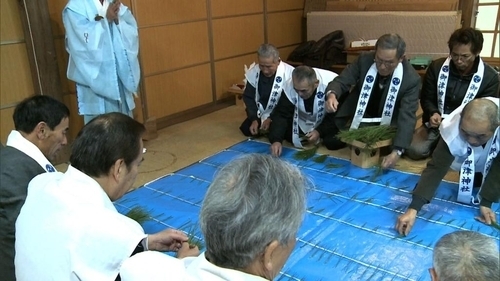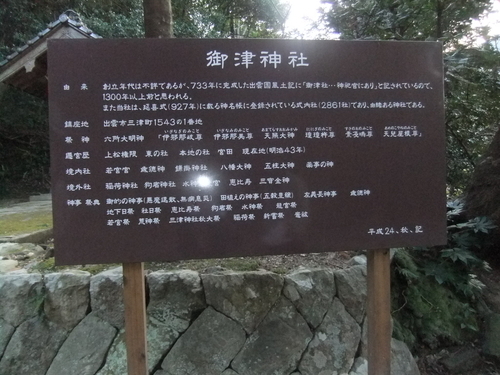三津浦
ENGLISH PAGE
| 浦名 | 三津浦(みつうら) |
|---|---|
| 神社名 | 御津神社 |
| 祭神 | 伊弉諾命 伊弉册命 |
| 所在地 | 出雲市三津町1593-1 |
地図
フォトギャラリー




浦巡りガイド
出雲国風土記には、「三津嶋。・・能呂志嶋。・・許豆嶋。紫菜生えり。・・・但、紫菜は、縦縫郡尤も優れり。」とあり注釈として「ウップルイノリ」の説明がある、と御津神社総代長さんに指摘されました。「ウップルイノリ」は、十六島浦の辺りでとれるものばかりと思いこんでいたのが、意外な感じがしました。海が荒れると命がけの採取となるのは三津浦も同じだと話しておられました。
また、御津神社の祭礼は、江戸時代に編纂された「雲陽誌」にある通りの祭事、「田植の神事」、「御的神事」を毎年正月7日(今年は1月8日)に執り行っておられます。「御的の神事」は、消炭で「鬼」と書いた杉板を神官が弓矢で射るというもので、゛郷土史さか゛によれば「田植の神事」は、松の葉を稲の苗に見立てて植え付けていると神官が「早くも大豊作」と宣言し、中殿から参拝者に餅まきをするとされています。また、お的の神事のいわれは、昔蒙古が襲来した時に神が弓を射たため恐れて逃げたという伝説によるとされ、今に伝わっています。
島根町野波浦の日御碕神社でも正月7日に「御田植祭」を行っていますが、ここは赤ちゃんから小中学生、年配の男女の参加があり賑やかな神事でした。
御津神社では、松の葉を使い、日御碕神社では、シバマツの葉を使っていました。
また、松江市鹿島町にも御津浦御津神社と音では全く同じ名前の神社がありますが、関係はないということでした。
旧社名は「熊野神社」であるが、文久三年の『四十二浦并道中記』には「六社大明神」となっている
旧社名は「熊野神社」であるが、文久三年の『四十二浦并道中記』には「六社大明神」となっている。また享保年間の『雲陽誌』にも「六社明神」となっており、祭神として「諾册の両尊、天照大神、瓊々杵尊、素盞鳴尊、児屋根尊」の六神を挙げている。「熊野」は「諾册の両尊」に祭祀が限定された時期の呼称ではなかろうか。
『雲陽誌』は同社を「風土記に載る御津社是なり」としている。今の御津神社ということであろう。また慶応二年に同社を参拝した小村和四郎重義は「六所大明神」としており、それを「御津社」と比定している。
『出雲国風土記』の「御津社」は式内社であり、風土記にみえる「御津浜 広さ三十八歩」、「御津島 紫菜生ふ」という「御津」世界の守護神であったと思われる。 社地には何回か変遷があったらしく、すでに『雲陽誌』段階において「本地社」と呼ばれる旧社の名がみえている。(関 和彦)

